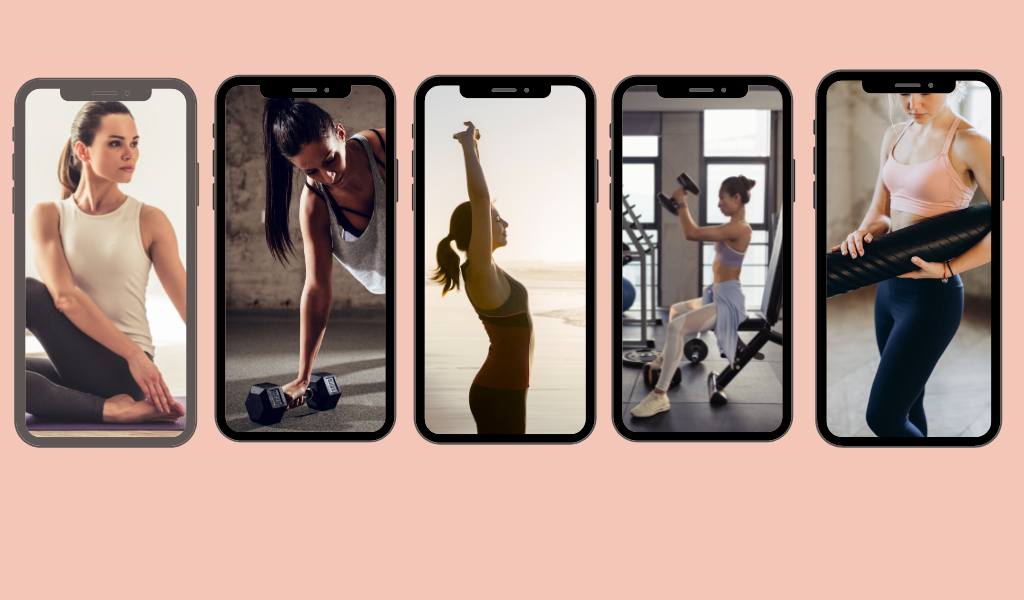A healthy, fit lifestyle will lead to an active body and a calm, rational mind. Many people begin their exercise routines with enthusiasm as well as high expectations.
However, because they don’t see immediate benefits, the majority of them quickly abandon this idea.
Sadly, the fundamental issue is that newly-minted athletes need help to monitor their progress. Technology provides a fix for this issue.
With the introduction of mobile fitness apps, users can track their progress and observe all the changes in real-time.
It’s not surprising that athletic powerhouses like Nike, Adidas, and Under Armour purchase and create fitness applications. I’ll go over the many types of fitness apps, how to make one, and how they can make money in this post.
Learn about the fitness app market
The fitness app market is expected to grow at a 23 percent CAGR thru the forecast period, according to a study and a forecast posted by Polaris Market Research in January 2019.
The market size is expected to reach $14.7 billion by 2026. According to a Statista analysis, the Fitness segment’s sales reached 4,024.9 million US dollars in 2021 alone and have been steadily increasing.
As a result, the revenue is anticipated to rise at a CAGR of 5.0 percent from 2019 to 2023, leading to a market size of $20,499 million by that year.
It implies that the demand for fitness applications is extending and is anticipated to do so as unique health and fitness characteristics are developed.
Types of fitness apps
Typically, fitness apps fall under one of the following categories:
• Exercise and workout applications
• Apps for gyms and fitness facilities
• Apps for nutrition and diet
• Apps for wellness
• All-in-one fitness apps
Let’s look at them in more detail:
- Exercise and workout applications
Training plans, workout manuals, exercises, and instructional videos can be found. The user experience should be the main focus of a successful application in this area.
For instance, it should be able to consider the user’s objective when developing a personalized training plan and tracking their progress.
- Apps for gyms and fitness facilities
Gyms and fitness centers create these kinds of apps to improve client connection. This category of apps should be capable of the following:
• Track each person’s development
• Provide a schedule of appointments
• Function as a method of paying for monthly subscriptions
• Give informative articles and instructional videos
• Watch live streams of seminars and training sessions
The company can create a stronger sales promotional offer for each gym member with access to their frequency and workout stats.
- Apps for nutrition and diet
Your diet and nutrition app may include a variety of users, including vendors, regular users, and nutritionists, depending on its design.
These apps assist users in changing their lifestyles, eating habits, and other areas, in addition to helping them lose weight.
A mobile app focused on nutrition should also be adapted to the demands of its users and have a standard set of necessary tools like:
• A diet plan
• An energy meter,
• A compilation of cooking videos
• A progress monitor
• Advice on sports diet and supplements.
• Messenger (if the app enables connection with a nutrition consultant)
- Apps for wellness
People frequently consider strategies to reduce screen usage while discussing wellness and mindfulness.
But what if you could use your phone to guide you in learning good habits? Meditation, yoga, and spiritual disciplines all fall under this category.
These apps typically publish motivational information, photographs, and videos showing various exercises and approaches.
- All-in-one fitness app
An all-in-one app typically integrates the features of several different app types simultaneously. An all-in-one fitness app might be a celebrity athlete’s app that teaches proper workout routines and includes a balanced diet schedule and other resources.
By including many functionalities that can be activated for different costs, monetization can simultaneously become quite flexible. For instance, a freemium approach can give users access to fundamental functions like calorie or step counting.
Advanced options, however, including a customized nutrition plan or a workout schedule, call for a monthly fee.
Users will find a more feature-rich app to be much handier, but creating and maintaining such complicated apps can be very expensive.
If you are interested in any of these, you should start a fitness mobile app development immediately.
Fitness app features and requirements
• Registration
Most apps require registration as a necessary step. It might be optional if your app is only a simple step counter.
However, customers should always register if you offer specific workout or diet regimens. By registering, you may collect more user information and customize your app experience.
• Customer profile
Allow users to control their physical information first. Height, weight, age, and other data allow users to customize workouts and get results more quickly.
• Work out the chart
Workout screens are required since tracking physical activity is the fundamental function of fitness apps. Charts may vary depending on the type of app, but the concept is the same.
• Statistics
Users unable to see visible changes can nevertheless comprehend their progress thanks to detailed statistics. Two categories of statistics exist:
- Global
It shows worldwide development over a selected period (week, month, year). These statistics can be used to monitor changes in a user’s weight, muscle mass, and level of exercise.
- Local
Users can track their progress from one training session to the next using these short-term data. Local statistics display heart rate, journey distance, and running cadence. Sportspeople can track their progress during each workout using these statistics.
Create a fitness app that displays statistics as charts and diagrams rather than text. Post-training statistics are more interesting when they are visualized.
A step-by-step guide to making a fitness app
There are several steps you should take to make the best fitness mobile app:
- Research the market
You have to first execute market research before creating your fitness application. Examine your rivals, spot market leaders, and try to identify what qualities they are using to draw customers.
Without detailed market analysis, you will ignore your targeted market and might not be sure of the benefits over your competitors.
- Establish feature set
Once your market research is complete, it’s time to create a feature list. Your software creators will be competent to understand your needs and decide on the best tech stack with the assistance of a thorough feature list.
You can even create a rough list by yourself. Later, you and your tech partner can fix the feature list and make it much more accurate.
Software specialists can help you calculate the expenses associated with creating a workout application.
- Specify project requirements
The discovery phase is a crucial step in creating a fitness app. A project specification and wireframes are created by a group of project managers, designers, developers, plus QA engineers.
You will still have all the documents needed to keep working on the product somewhere else, even if you decide to quit working with the company.
- Determine the project cost
It’s now time to make a project cost estimation. Our calculations show that the price for designing a fitness app ranges from $60,000 up to $91,850.
The final expense is defined by the number of platforms for which the application is being created, the intricacy of the characteristics, post-release support, including various other factors.
Before reaching out to your vendor, remember particular needs since it is difficult to estimate your task’s pricing without comprehending them.
Conclusion:
The creation of fitness apps can be difficult, much like the development of any other program. But you can judge whether a fitness app is popular and valuable by ensuring it has the greatest features that users will find helpful over the long term.
Make sure you can provide customized fitness programs tailored to people’s demands to achieve that. Your fitness app is more likely to stand out and be successful if it truly wants to help users reach their fitness objectives through various features.
How Do You Make a Fitness Mobile App?

















